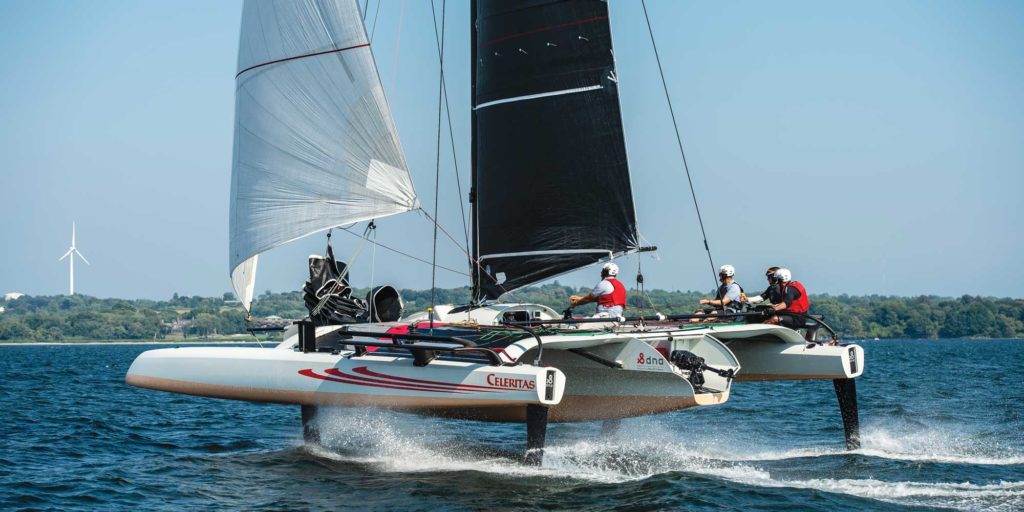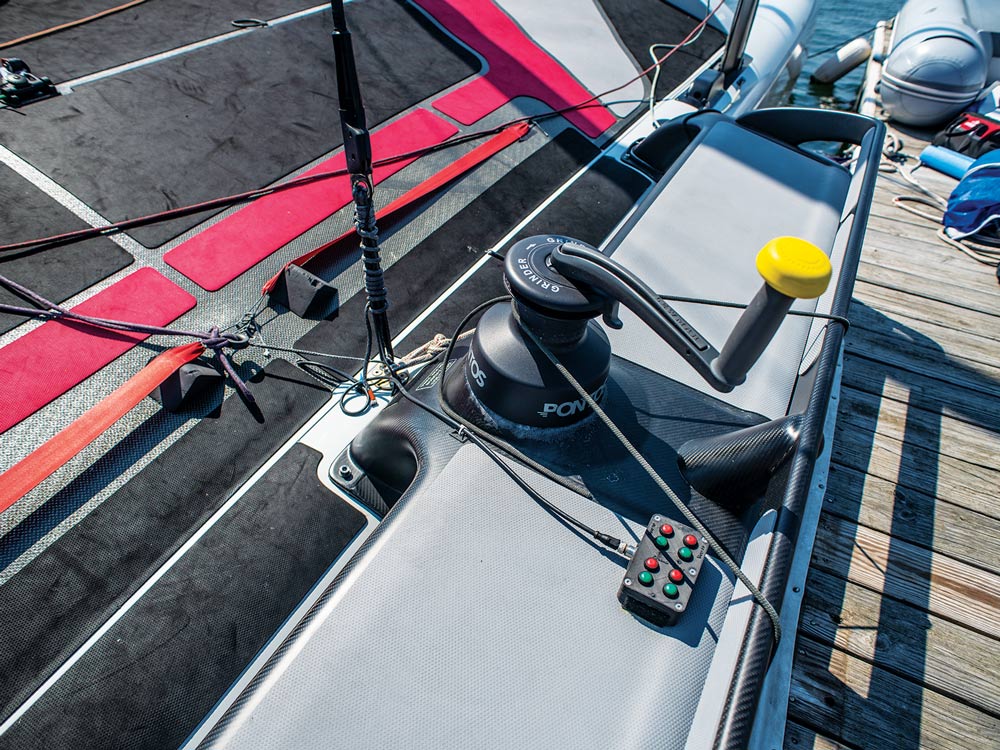
Seventy-five-year-old foiling fanatic Malcolm Gefter, dressed in tattered neoprene sailing gear, with an impact-padded PFD and sailing helmet loosely clipped and askew, is beaming ear to ear as he watches his 35-foot trimaran stream across the horizon, hovering 3 or 4 feet above the water with plumes of spray spitting from its rudders. We’re chasing them in our RIB, the big diesel outboard humming at full speed. On board the trimaran is one experienced pro and three of our Boat of the Year personnel. The three of them have zero foiling experience and less than 30 minutes on this boat.
Yet, there is BOTY judge Tom Rich, more familiar helming his 41-foot IMS-era lead dragger, perched on the TF10’s bench seat, carbon tiller in his left hand, just absolutely sending the boat down Narragansett Bay at 25 knots. Rich is wide-eyed, white-knuckled and trying like hell not to wipe out. But otherwise, he’s comfortable. And confident.
“See? No problem. He’s doing it,” Gefter mumbles nonchalantly. “I told you they’d foil on their first try.”
No sooner do the words leave Gefter’s zinc-covered lips does the trimaran’s weather hull plunge, punch a hole in the bay, lift right back up and get going again as if nothing happened.
“In a big catamaran, like the M32, that would have been a pitch-pole or capsize, for sure,” Gefter says. “With this boat, you get the buoyancy from the center hull, so that’s not going to happen.”
Gefter would know. His previous boat was a carbon Marstrom 32 catamaran that required experienced dudes and a chase boat every time he wanted to go yachting. He’s done with that. This TF10 trimaran is his next boat, a product of his hyperanalytical mind. He’s been hands-on with the design and build since inception, and has invested a small fortune of his own time and money.
“The concept was to build a boat that takes advantage of foiling capability and to bring it to the realm of the ordinary, but competitive, high-performance sailor,” Gefter explains to the Boat of the Year judges. “Guys from TP52s, Melges 32s, etc., that ought to be able to take a step up to this boat and go foiling.”
When it comes to fast and stable flight, what makes the TF10 different from smaller foiling craft such as Moths and other singlehanders, which use human weight as righting moment, is the trimaran’s “mechanics,” Gefter says. “This boat is about the mechanics and how you use them.” That, and the undeniable fact that a trimaran is a more stable and comfortable platform for first‑time foilers like our judges.
“You might get a little wet,” Gefter says. “But it will be possible for each of you to foil from the helm on your first go.”

Before setting off from the dock, Gefter explains the three-sail-inventory (gennaker, reefable jib and main). The mechanics he’d referred to earlier are the four appendages — two large L-shaped daggerboards and two high-aspect T-rudders. All four stay down, he says, for what’s called four-point foiling, but the windward board can be raised upwind for a fraction of a speed gain. Off-the-wind sailing is another story; all four must remain down all the time. Four-button control modules to control “lift and no-lift” for each of the appendages are mounted at each of the trimming stations.
Gefter’s TF10 foiling 101 is as such: “The windward rudder is pulling down to create righting moment, and the leeward rudder is lifting up to create lift and adjust pitch. The windward daggerboard is providing most of the lift, and the windward board is providing slightly less lift.”
Like any other boat, the TF10 sails upwind with leeward heel, and with the big center hull, the sensation is similar to any other sportboat. Gefter sometimes drives from the center cockpit, but mostly from the bench alongside the main trimmer. Once the gennaker is deployed, driver and trimmers work in sync to level the boat, and get the foils in balance and the boat’s attitude just right.
“It’s not easy to do,” Gefter says, “but it’s doable and straightforward once you do.”
Built by DNA Performance Sailing in Holland, the TF10 is a carbon-fiber collector’s item, but fairly simple in the grand scheme, a boat that will demand constant attention and tweaking. A boat captain — or at least an experienced high-performance nipper — will be essential to make good use of every outing.
“Time on the water with this thing is critical to learning how to sail it, and that’s going to be the biggest challenge for any owner,” Allen says. “If you want to go sailing, you’ll need to have the right conditions, and the guys ready to go. With these types of boats, there will always be projects once you’re back at the dock, but it is what it is.”
While the first seven boats are built by DNA, the original group of owners — New York YC members — own the aluminum tooling, Gefter says, so they can build boats whenever and wherever they want. “It has to be said how well it’s built,” says judge Greg Stewart. “It’s all nice and fair. The boat looks awesome at the dock, with a very cool profile.”
The trampoline is a carbon fabric, creating a strong, impermeable shield to sprint across. It blocks spray too, so the boat is dry until you get aggressive with its fast weather-heel mode. It’s loaded with standard high-performance multihull controls: a diamond tensioned carbon rig with rotation assembly, and a wishbone boom that assists with the end-plate effect of a deck sweeper main.
The boat is sailed with four to five crew, positioned in different places to help trim and balance. Downwind, one crew moves inboard to the cockpit winch, grinding for the trimmer, who’s outboard on the bench with the main trimmer and driver. For righting moment and safety, Gefter says, they never allow more than four people on the bench at once.
While on the topic of safety, Gefter admits they have yet to capsize or pitch-pole the TF10, but could it? “Sure, it can happen, but it will be rare,” he says matter-of-factly. “But the trimaran configuration is so forgiving. The center hull’s flotation is significant, and at 2,600 pounds, it’s much heavier than the Marstrom, and that’s a stabilizing damping force on the skittishness. If it capsizes, it will turtle, which of course would not be pleasant.”
The judges never come close enough to finding out, and Rich is happy to report that he is well at ease cruising at altitude at 25 knots. Stewart, too, has the ride of his life. “It was a breakthrough day of sailing,” he says. “Just windy enough it wasn’t scary at all. Another 5 knots and we probably would have been putting in a reef and been just as fine.”
Boat of the Year worthy? Most definitely, but too narrow of a niche, Allen says. “You’ll definitely be having guys on the payroll to sail it, and the fleet will always be relatively small — maybe 10 or 15 at most — but they’ll have a lot of fun together doing point-to-point racing and trying different formats, especially when they’ve all got it wired.”
Rich agrees, adding that the TF10 checked all its boxes: It’s very well-built, sails great and meets its design criteria. “They guaranteed foiling, and we did,” he says. “The speed numbers Malcolm quoted about when the boat would do certain things was right on. It went upwind amazingly well too. We were flying upwind at 15 knots at pretty high angles.”









